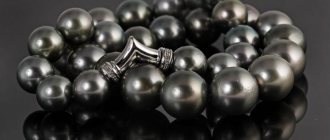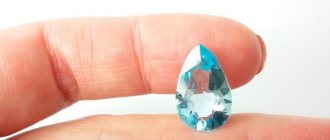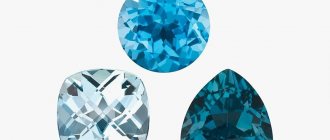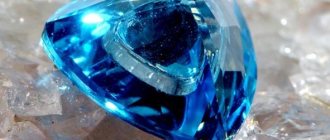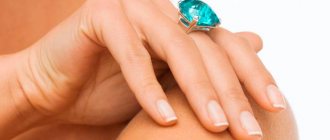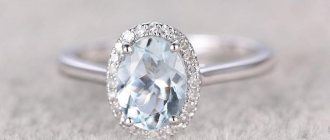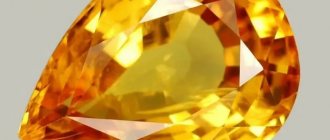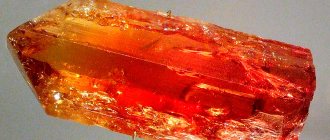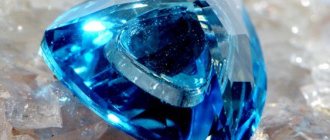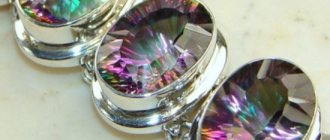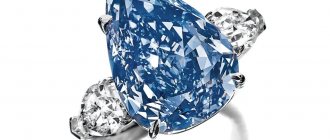Description of the stone
Precious Swiss topaz.
Swiss blue topaz is a type of gemstone that combines shades of bright blue in its facets, complemented by gray tints. The unique color and mirror-like shine distinguish this mineral from other varieties of blue topaz.
The Swiss gem, in addition to visual pleasure, will bring psychological and emotional benefits to its owner, give him confidence and attractiveness, and awaken positive thoughts in him.
The natural mineral belongs to the group of semi-precious aluminum silicates.
The precious gem has the following characteristics:
- high hardness and density;
- glass or mother-of-pearl overflows;
- absolute transparency;
- light refraction ability;
- small gray inclusions that are not a defect.
Chemical and physical properties
Topaz Swiss trillion
Topaz is an aluminum fluorosilicate formed in granitic pegmatites in close proximity to feldspars and rauchtopazes.
This mineral is characterized by:
- high density and hardness;
- absolute transparency;
- pronounced glass luster;
- microscopic inclusions of other rocks, appearing as reflections of gray shades;
- light refraction effect;
- susceptible to fading when exposed to ultraviolet rays.
Origin story
It is no coincidence that the stone received this name. Its first small deposits were discovered in the Swiss Alps. However, these reserves have long since dried up, although treasure hunters have found isolated samples of the Swiss blue mineral.
Natural blue topaz was rare and therefore expensive. In the early 1970s. Research into gemstone processing methods has shown that colorless topaz is a good material for cutting.
It is abundant, available in large crystals of high clarity, and can be processed to a uniform blue color.
Thus, 3 varieties of blue topaz were created:
- Sky Blue - a gem of a heavenly hue;
- Swiss Blue - bright blue stone;
- London Blue is a dark blue crystal.
Stone deposits
In 1969, the mineral was named the “Jewel of Texas” in honor of the discovery of small deposits of pale blue topaz there. It evolved as a crystalline material in granitic rocks and lava flows.
The modern natural resources of colorless stone are located in Sri Lanka. The most common places where Swissy is harvested are Ukraine, Namibia, Australia and Japan.
Gem deposits in these countries yield a good harvest of bright blue minerals. However, the International Association of Gemologists rarely classifies them as Swiss topaz because they differ from natural Swiss ones.
Some impurities included in the stones reflect the specifics of the deposit and give them a different shade. Not a single mineral brought from other regions can compete in the beauty of blue with Swiss finds.
Mineral processing
The icy pastel blue color is created by exposing colorless topaz to radiation and then heating. Lighter shades are created by electrons; dark blue, familiar as London or Swiss blue, by exposure to neutrons.
This can take years as the high energy processes require storing the gem before it can be safely released. Scientists vary the processing procedure to produce jewels with a wide range of blues.
Swiss topaz is formed by a combination of neutron and electron processing in a linear accelerator and nuclear reactor, then heated to 200°C for 180 hours, producing vibrant blue colors. After irradiation, the product needs a cooling time of 8 months.
Many people are concerned about the safety of blue topaz due to the use of radiation. Facilities that process stones in this manner are licensed by the Nuclear Regulatory Commission.
The production of precious crystals, according to the technological maps approved by the Commission, makes Swiss topazes harmless.
Legislation requires that all irradiated stones be stored in a secure facility after processing. At the same time, they are monitored until the residual radiation decreases to a level that is safe for use in jewelry. This procedure guarantees the safety of copies.
Processing process
Currently, the desired shades of Swiss topaz are obtained by irradiation and subsequent heating. Colorless crystals, after exposure to electrons, turn pale blue. To obtain more saturated shades of blue, neutron irradiation is used.
To prevent radiation from dark blue stones, crystals after refining are monitored until the radiation completely disappears. When they hit the shelves of jewelry stores, stones are usually absolutely safe.
Varieties of shades
3 varieties of processed blue topaz became dominant:
- Swiss Blue is a bright blue topaz with a light to moderate tone and saturation. The vibrant color of Swiss blue is reminiscent of the rich hue of the Caribbean, which is close to the color of Brazilian Paraiba tourmaline. It is darker than heavenly and has a slightly "electric" tone.
- London Blue is a medium to dark blue topaz. London Blue is so deep that the slightly greenish tint is barely visible when viewed from an angle. It is exactly like tanzanite. This color is also called “inky” and “stylish”. This stone is considered the most valuable among other members of the topaz family.
- Sky Blue is the lightest, most subtle stone giving a bluish glow.
It is difficult to determine the boundary where a shade of blue ends and another begins. A simple rule of thumb applies around the world: medium blue is Swiss and dark blue is London.
Three shades of one stone.
Areas of application
For fashionistas, topaz symbolizes affordable jewelry with precious stones in this color scheme.
The meaning of the gem in astrology is to bring new life and positive energy to those who believe in a higher power.
For the Hindu religion, it is the symbol of the kalpa tree. It is considered one of the 9 sacred stones in Hinduism.
Swiss topaz is in great demand in the jewelry industry. Its extraordinary beauty attracts the attention of the fair sex from all over the world. Stones are inserted into rings, earrings, bracelets, chains made of gold and platinum.
Price
The Internet offers an assortment of different quality and origin (price, rub.):
- bead (cut, 12-17 mm, pale blue; India) – 600;
- jewelry insert (diameter 6-7 mm; Brazil) – 630-900.
In expensive lots, all data is indicated, including special classification. For example, “Bright blue topaz, weight 52.1 carats, size 22.1x21.6 mm (swiss0041), country of origin Brazil” goes for 42 thousand rubles. An 11-carat cartridge with similar characteristics will cost four times less.
Decoration with SWISS topaz
The price of jewelry is also determined by the material of the frame. Their order is thousands of rubles. So, gold earrings or a ring can be bought for 15-25, studs - 5+, pendants - 2.5+ thousand rubles.
Physicochemical characteristics
The crystals are found in felsic igneous rocks such as rhyolite and in metamorphic rocks. In addition, topaz elements are found in pegmatite dikes and are often by-products of mining other precious minerals such as beryl.
Swiss topaz, composed of aluminum, silicon and oxygen, has a hardness rating of 8 on the Mohs scale. Its strength remains unchanged even after color enhancement procedures.
Physical and chemical properties:
- Rhombic system, rhombic-bipyramidal type of symmetry.
- The cleavage is perfect according to (001), unclear according to (101) and (011).
- The fracture ranges from stepwise to conchoidal.
- The shape of the crystals is prismatic, elongated along the C axis.
- The mineral does not melt and becomes cloudy when heated strongly.
- Swiss topaz decomposes with phosphorus salt to form a SiO2 skeleton.
- Behavior in acids: insoluble in HCl, releases a little HF in H2SO4 upon prolonged heating, dissolves in HNO3 after fusion with calcium carbonate.
- Formula - Al2 [SiO4] (F, OH)2.
- Content (in%): А2О3 (48.2-62); SiO2 (28.2-39); F 13 to 20.4; H2O up to 2.45. Impurities of iron, chromium, magnesium, titanium, and vanadium are noted.
Healing properties
The gemstone does not cause harm in any way, but has a positive effect on health problems such as:
- immune system disorder;
- stomach problems;
- liver and kidney diseases;
- diabetes;
- pain in the joints and lower back;
- obesity;
- headache;
- hysteria;
- sore throat.
Swiss topaz is worn to make one receptive to love and friendship, because it is capable of:
- improve communication and self-expression skills;
- bring peace of mind, stability of mind and balance the thyroid gland;
- strengthen existing abilities;
- unify body and mind through spiritual vibrations;
- eliminate anger, misgivings and anxiety.
Other properties of the stone:
- changes color in the presence of poisoned food or drinks;
- symbolizes honesty, clarity of feelings and deep emotional attachment;
- good for fourth and nineteenth wedding anniversaries;
- can gently heal past grievances and calm feelings, which will not allow you to get confused in false images from the past;
- popular as an amulet that protects the owner from nightmares;
- helps you overcome your own limits, gives you a chance to improve your existing skills;
- supports dreams and provides suitable opportunities;
- increases creativity and brings new ideas;
- relieves negative feelings, prevents stress;
- restores calm, brings bright colors to life, stimulates mutual understanding.
Swiss Topaz is the traditional birthstone for December.
Magic properties
Swiss topaz ring
The main magical purpose of Swiss topaz is to ensure the mental balance of its owner, helping to unite soul and body. The stone eliminates anger, aggression, resentment and anxiety, makes the mind and feelings clear.
It is believed that with the help of blue topaz you can strengthen your talents and abilities, get rid of negative feelings, and aim to achieve your dreams.
The stone helps to establish relationships and find ways of mutual understanding.
It can be used as a talisman against ill-wishers and their evil intentions.
Compatibility with zodiac signs
Topaz is associated with Jupiter, the largest planet in the solar system. It has always been considered the abode of greatness. Jupiter is the ruler of Sagittarius and Pisces.
The stone is also favorable for Aries, Cancer and Leo, Scorpio. He will protect and inspire Virgos. For Taurus and Gemini, such an amulet will not bring a favorable result, but it will not cause harm either.
According to astrological rules, Libra, Capricorn and Aquarius cannot wear this mineral all the time. You can wear jewelry to an event if it is irresponsible.
People born under the sign of Sagittarius can wear the mineral as a talisman for good luck. This is their stone.
Stone in gold and silver for Sagittarius and Pisces.
How to distinguish a real stone from a fake
The only sure way to determine originality is to find a certified gemologist to perform tests. Most jewelry stores have such a specialist.
So much work goes into Swiss topaz that without proper gemstone equipment it is difficult to determine its authenticity.
Several ways to visually distinguish Swiss Blue from a fake:
- original stones are inlaid with expensive metal;
- when touched, a polished, slippery surface is felt;
- the mineral cannot be easily scratched, and cheap quartz will remain damaged;
- in the rays of the sun, shades of gray are observed on the edges of the original product;
- real stone is heavy;
- the actual crystal remains cool even with prolonged contact with the body.
Similar products made from processed citrine or amethyst - varieties of quartz - act as counterfeits.
Dangerous processing
Blue stones have defects in the crystal lattice. Therefore, they can be easily refined by firing. Today this method is the most common.
Previously, craftsmen treated stone with reagents. But they abandoned this method because the crystal quickly faded.
Another method for refining sky and Swiss topaz is radiation irradiation. But failure to comply with the technology makes the stones hazardous to health. They can cause cancer. Such samples are usually sold without quality certificates on the “black” markets. In the last century, the demand for blue stones decreased for a time due to rumors about the use of radioactive methods of refining.
It is difficult for a non-professional to identify such stones. The only sign is the excessively intense color of the mineral.
Modern processing technologies are safe for humans. A lot of time passes between processing and cutting. Therefore, the radiation activity of stones is at a natural level.
We recommend purchasing Swiss or sky blue topaz only from jewelry stores that are willing to provide certificates. Or from a jeweler that has been proven over the years.
Mineral cost
Swiss Blue is a good replacement for expensive aquamarine, sapphire and tanzanite. The richer the shade of the gem, the more expensive it is. Swiss topaz is valued higher than the common blue mineral because it is less common on the market.
When the stone was first introduced, it sold for between $20 and $40 per carat. But the oversupply led to a sharp drop in wholesale prices - down to several dollars per carat. Today, Swiss crystal is found mainly in the mass market, and its price has the greatest influence on sales.
Swiss topaz is one of the most beautiful and famous members of the family. Its price varies from $6 to $15 per carat and above. Swiss Blue's main consumer markets are the USA, Asia and Europe.
Where is it used?
The only area of application for Swiss Blue is high jewelry and stone collecting.
Ring with Swiss Blue topaz
Swiss Blue is considered semi-precious, but is suitable as a status gift.
Studs and a pendant are suitable for girls. A mature lady will be decorated with a set of larger earrings, a ring, and a pendant. They choose an outfit in blue tones or white, black, gray.
The setting of jewelry is gold, less often - silver. Stones look good in a white frame. They don’t make him “rich”: Swiss Blue is self-sufficient. Metal is needed only as protection against deformation and a functional part of the decoration.
Storage and care
Timeless, elegant, classic shades guarantee a beautiful tone when used correctly. The radiation and heat treatment used to produce the blue color creates a powerful effect that protects the stone from fading colors.
However, the jewelry has a risk of splintering if it is handled roughly. Therefore, Swiss blue topaz should be protected from strong impacts. It is recommended to clean it with liquid dish soap and a soft toothbrush or sponge.
Steam and ultrasonic cleaning cannot be used. Products should be stored in a dark place, protected from direct sunlight. For this purpose, you can take a box with a lid in which other jewelry will not be stored.
